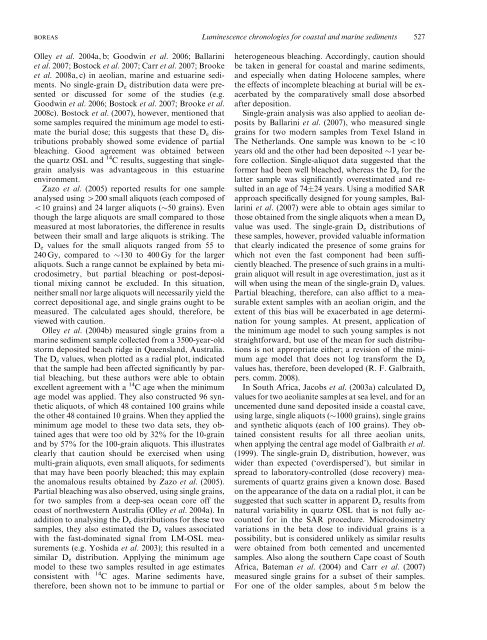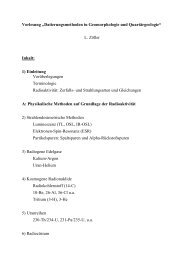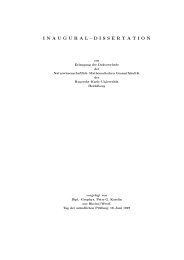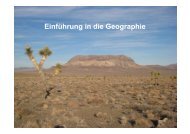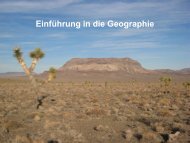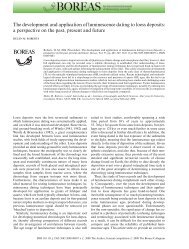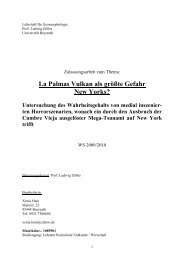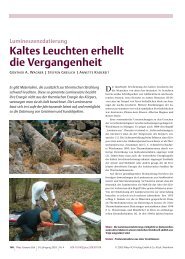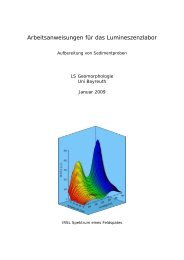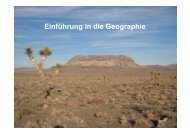Luminescence chronologies for coastal and marine sediments
Luminescence chronologies for coastal and marine sediments
Luminescence chronologies for coastal and marine sediments
Create successful ePaper yourself
Turn your PDF publications into a flip-book with our unique Google optimized e-Paper software.
BOREAS <strong>Luminescence</strong> <strong>chronologies</strong> <strong>for</strong> <strong>coastal</strong> <strong>and</strong> <strong>marine</strong> <strong>sediments</strong> 527<br />
Olley et al. 2004a, b; Goodwin et al. 2006; Ballarini<br />
et al. 2007; Bostock et al. 2007; Carr et al. 2007; Brooke<br />
et al. 2008a, c) in aeolian, <strong>marine</strong> <strong>and</strong> estuarine <strong>sediments</strong>.<br />
No single-grain D e distribution data were presented<br />
or discussed <strong>for</strong> some of the studies (e.g.<br />
Goodwin et al. 2006; Bostock et al. 2007; Brooke et al.<br />
2008c). Bostock et al. (2007), however, mentioned that<br />
some samples required the minimum age model to estimate<br />
the burial dose; this suggests that these D e distributions<br />
probably showed some evidence of partial<br />
bleaching. Good agreement was obtained between<br />
the quartz OSL <strong>and</strong> 14 C results, suggesting that singlegrain<br />
analysis was advantageous in this estuarine<br />
environment.<br />
Zazo et al. (2005) reported results <strong>for</strong> one sample<br />
analysed using 4200 small aliquots (each composed of<br />
o10 grains) <strong>and</strong> 24 larger aliquots (50 grains). Even<br />
though the large aliquots are small compared to those<br />
measured at most laboratories, the difference in results<br />
between their small <strong>and</strong> large aliquots is striking. The<br />
D e values <strong>for</strong> the small aliquots ranged from 55 to<br />
240 Gy, compared to 130 to 400 Gy <strong>for</strong> the larger<br />
aliquots. Such a range cannot be explained by beta microdosimetry,<br />
but partial bleaching or post-depositional<br />
mixing cannot be excluded. In this situation,<br />
neither small nor large aliquots will necessarily yield the<br />
correct depositional age, <strong>and</strong> single grains ought to be<br />
measured. The calculated ages should, there<strong>for</strong>e, be<br />
viewed with caution.<br />
Olley et al. (2004b) measured single grains from a<br />
<strong>marine</strong> sediment sample collected from a 3500-year-old<br />
storm deposited beach ridge in Queensl<strong>and</strong>, Australia.<br />
The D e values, when plotted as a radial plot, indicated<br />
that the sample had been affected significantly by partial<br />
bleaching, but these authors were able to obtain<br />
excellent agreement with a 14 C age when the minimum<br />
age model was applied. They also constructed 96 synthetic<br />
aliquots, of which 48 contained 100 grains while<br />
the other 48 contained 10 grains. When they applied the<br />
minimum age model to these two data sets, they obtained<br />
ages that were too old by 32% <strong>for</strong> the 10-grain<br />
<strong>and</strong> by 57% <strong>for</strong> the 100-grain aliquots. This illustrates<br />
clearly that caution should be exercised when using<br />
multi-grain aliquots, even small aliquots, <strong>for</strong> <strong>sediments</strong><br />
that may have been poorly bleached; this may explain<br />
the anomalous results obtained by Zazo et al. (2005).<br />
Partial bleaching was also observed, using single grains,<br />
<strong>for</strong> two samples from a deep-sea ocean core off the<br />
coast of northwestern Australia (Olley et al. 2004a). In<br />
addition to analysing the D e distributions <strong>for</strong> these two<br />
samples, they also estimated the D e values associated<br />
with the fast-dominated signal from LM-OSL measurements<br />
(e.g. Yoshida et al. 2003); this resulted in a<br />
similar D e distribution. Applying the minimum age<br />
model to these two samples resulted in age estimates<br />
consistent with 14 C ages. Marine <strong>sediments</strong> have,<br />
there<strong>for</strong>e, been shown not to be immune to partial or<br />
heterogeneous bleaching. Accordingly, caution should<br />
be taken in general <strong>for</strong> <strong>coastal</strong> <strong>and</strong> <strong>marine</strong> <strong>sediments</strong>,<br />
<strong>and</strong> especially when dating Holocene samples, where<br />
the effects of incomplete bleaching at burial will be exacerbated<br />
by the comparatively small dose absorbed<br />
after deposition.<br />
Single-grain analysis was also applied to aeolian deposits<br />
by Ballarini et al. (2007), who measured single<br />
grains <strong>for</strong> two modern samples from Texel Isl<strong>and</strong> in<br />
The Netherl<strong>and</strong>s. One sample was known to be o10<br />
years old <strong>and</strong> the other had been deposited 1 year be<strong>for</strong>e<br />
collection. Single-aliquot data suggested that the<br />
<strong>for</strong>mer had been well bleached, whereas the D e <strong>for</strong> the<br />
latter sample was significantly overestimated <strong>and</strong> resulted<br />
in an age of 7424 years. Using a modified SAR<br />
approach specifically designed <strong>for</strong> young samples, Ballarini<br />
et al. (2007) were able to obtain ages similar to<br />
those obtained from the single aliquots when a mean D e<br />
value was used. The single-grain D e distributions of<br />
these samples, however, provided valuable in<strong>for</strong>mation<br />
that clearly indicated the presence of some grains <strong>for</strong><br />
which not even the fast component had been sufficiently<br />
bleached. The presence of such grains in a multigrain<br />
aliquot will result in age overestimation, just as it<br />
will when using the mean of the single-grain D e values.<br />
Partial bleaching, there<strong>for</strong>e, can also afflict to a measurable<br />
extent samples with an aeolian origin, <strong>and</strong> the<br />
extent of this bias will be exacerbated in age determination<br />
<strong>for</strong> young samples. At present, application of<br />
the minimum age model to such young samples is not<br />
straight<strong>for</strong>ward, but use of the mean <strong>for</strong> such distributions<br />
is not appropriate either; a revision of the minimum<br />
age model that does not log trans<strong>for</strong>m the D e<br />
values has, there<strong>for</strong>e, been developed (R. F. Galbraith,<br />
pers. comm. 2008).<br />
In South Africa, Jacobs et al. (2003a) calculated D e<br />
values <strong>for</strong> two aeolianite samples at sea level, <strong>and</strong> <strong>for</strong> an<br />
uncemented dune s<strong>and</strong> deposited inside a <strong>coastal</strong> cave,<br />
using large, single aliquots (1000 grains), single grains<br />
<strong>and</strong> synthetic aliquots (each of 100 grains). They obtained<br />
consistent results <strong>for</strong> all three aeolian units,<br />
when applying the central age model of Galbraith et al.<br />
(1999). The single-grain D e distribution, however, was<br />
wider than expected (‘overdispersed’), but similar in<br />
spread to laboratory-controlled (dose recovery) measurements<br />
of quartz grains given a known dose. Based<br />
on the appearance of the data on a radial plot, it can be<br />
suggested that such scatter in apparent D e results from<br />
natural variability in quartz OSL that is not fully accounted<br />
<strong>for</strong> in the SAR procedure. Microdosimetry<br />
variations in the beta dose to individual grains is a<br />
possibility, but is considered unlikely as similar results<br />
were obtained from both cemented <strong>and</strong> uncemented<br />
samples. Also along the southern Cape coast of South<br />
Africa, Bateman et al. (2004) <strong>and</strong> Carr et al. (2007)<br />
measured single grains <strong>for</strong> a subset of their samples.<br />
For one of the older samples, about 5 m below the


